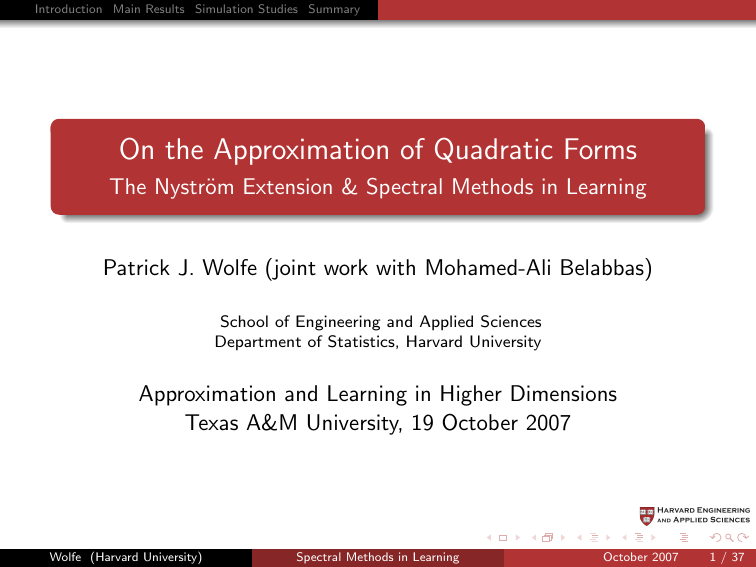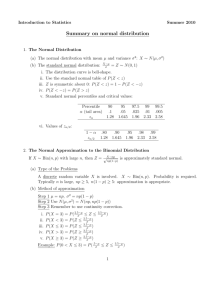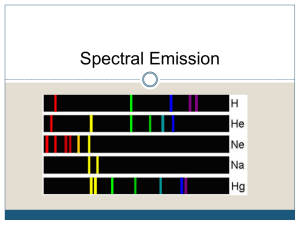On the Approximation of Quadratic Forms
advertisement

Introduction Main Results Simulation Studies Summary
On the Approximation of Quadratic Forms
The Nyström Extension & Spectral Methods in Learning
Patrick J. Wolfe (joint work with Mohamed-Ali Belabbas)
School of Engineering and Applied Sciences
Department of Statistics, Harvard University
Approximation and Learning in Higher Dimensions
Texas A&M University, 19 October 2007
Wolfe (Harvard University)
Spectral Methods in Learning
October 2007
1 / 37
Introduction Main Results Simulation Studies Summary
Outline
Approximation of quadratic forms in learning theory
1
Introduction: Spectral Methods in Learning
Spectral methods and statistical learning
Approximating a positive semi-definite kernel
Discriminating between data and information
2
Nyström Approximation and Multi-Index Selection
The Nyström extension as an approximation method
Randomized multi-index selection by weighted sampling
Deterministic multi-index selection by sorting
3
Numerical Results and Algorithmic Implementation
Approximate sampling
Low-rank kernel approximation
Methods for nonlinear embeddings
Wolfe (Harvard University)
Spectral Methods in Learning
October 2007
2 / 37
Introduction Main Results Simulation Studies Summary
Outline
Approximation of quadratic forms in learning theory
1
Introduction: Spectral Methods in Learning
Spectral methods and statistical learning
Approximating a positive semi-definite kernel
Discriminating between data and information
2
Nyström Approximation and Multi-Index Selection
The Nyström extension as an approximation method
Randomized multi-index selection by weighted sampling
Deterministic multi-index selection by sorting
3
Numerical Results and Algorithmic Implementation
Approximate sampling
Low-rank kernel approximation
Methods for nonlinear embeddings
Wolfe (Harvard University)
Spectral Methods in Learning
October 2007
2 / 37
Introduction Main Results Simulation Studies Summary
Outline
Approximation of quadratic forms in learning theory
1
Introduction: Spectral Methods in Learning
Spectral methods and statistical learning
Approximating a positive semi-definite kernel
Discriminating between data and information
2
Nyström Approximation and Multi-Index Selection
The Nyström extension as an approximation method
Randomized multi-index selection by weighted sampling
Deterministic multi-index selection by sorting
3
Numerical Results and Algorithmic Implementation
Approximate sampling
Low-rank kernel approximation
Methods for nonlinear embeddings
Wolfe (Harvard University)
Spectral Methods in Learning
October 2007
2 / 37
Introduction Main Results Simulation Studies Summary
Spectral Methods Kernel Approximation Data vs. Information
Spectral Methods in Learning
The discrepancy between data and information
What role do spectral methods play in statistical learning?
Goal: get relevant “information” about very large datasets in
very high dimensional spaces
Image segmentation, low-dimensional embeddings, . . .
What is the “relevant” information contained in the data set?
Spectral methods reduce this question to finding a low-rank
approximation to a symmetric, positive semi-definite (SPSD)
kernel—equivalently, a quadratic form
They can be quite effective, and see wide use:
Older methods: principal components analysis (1901),
multidimensional scaling (1958), . . .
Newer methods: isomap, Laplacian eigenmaps, Hessian
eigenmaps, diffusion maps, . . .
Wolfe (Harvard University)
Spectral Methods in Learning
October 2007
3 / 37
Introduction Main Results Simulation Studies Summary
Spectral Methods Kernel Approximation Data vs. Information
Application of Low-Rank Approximations to Learning
Inner and outer characteristics of the point cloud
Let {x1 , . . . , xn } be a collection of data points in Rm . Spectral
methods can be classified according to whether they rely on:
Outer characteristics of the point cloud (PCA, discriminants).
Here we work directly in the ambient space. Require
spectral analysis of a positive-definite kernel of
dimension m, the extrinsic dimensionality of the data.
Inner characteristics of the point cloud (MDS, extensions).
Embedding requires the spectral analysis of a kernel
of dimension n, the cardinality of the point cloud.
The spectral analysis task typically consists of finding a rank-k
approximation to a symmetric, positive semi-definite matrix.
Wolfe (Harvard University)
Spectral Methods in Learning
October 2007
4 / 37
Introduction Main Results Simulation Studies Summary
Spectral Methods Kernel Approximation Data vs. Information
How to Approximate an SPD Matrix, in Theory?
Finding a low-rank approximation is easy. . .
An SPSD matrix G can be written in spectral coordinates
G = UΛU T ,
where U is orthogonal and Λ = diag(λ1 , . . . , λn ) is diagonal.
The λi ’s are the eigenvalues of G , ordered such that
λ1 ≥ λ2 ≥ . . . ≥ λn ≥ 0, and the ui ’s are the eigenvectors.
For any unitarily invariant norm k · k, we have that
ek
kG − G
argmin
=
UΛk U T =: Gk ,
e : rank(G
e )=k
G
where Λk = diag(λ1 , λ2 , . . . , λk , 0, . . . , 0)
Wolfe (Harvard University)
Spectral Methods in Learning
October 2007
5 / 37
Introduction Main Results Simulation Studies Summary
Spectral Methods Kernel Approximation Data vs. Information
How to Approximate an SPD Matrix, in Practice?
Finding a low-rank approximation is hard!
Changing to spectral coordinates is done using the Singular Value
Decomposition of G , which requires O(n3 ) operations
On a Pentium IV 3GHZ desktop
PC, with 1GB RAM, 512k Cache:
Extrapolating to
n = 106 , factoring G
takes more than 4
months.
When n increases, G
quickly becomes too
large to be stored in
memory
Wolfe (Harvard University)
Spectral Methods in Learning
October 2007
6 / 37
Introduction Main Results Simulation Studies Summary
Spectral Methods Kernel Approximation Data vs. Information
Approximating Large Kernels
How to discriminate between data and information?
This presents a practical problem for large data sets!
A commonly used “trick” is to sparsify the kernel.
Fix ε > 0. If Gij ≤ ε, set Gij = 0
Questions: How to choose ε? How accurate is the result?
Alternative approach: discard some of the data.
How to construct a low-rank approximation using just some of
the data? The Nyström extension provides an answer
The basic idea is as follows:
Write G = X T X , so that G is a Gram matrix for vectors
X1 , . . . , Xn .
Choose a subset I of vectors Xi and their correlations with all
e.
the other vectors to find a low-rank approximation G
Wolfe (Harvard University)
Spectral Methods in Learning
October 2007
7 / 37
Introduction Main Results Simulation Studies Summary
Spectral Methods Kernel Approximation Data vs. Information
A Provably Good Low-Rank Approximation
Our main result on approximating quadratic forms
How to choose I : |I | = k so as to minimize kG − G̃ k?
This is equivalent to asking: “How to choose the most
informative part from our dataset?”—most informative being
conditioned on our reconstruction scheme
There are
n!
k!(n−k!)
multi-indices—no hope of enumerating
We define the following distribution on multi-indices:
det(GI ×I )
|I |=k det(GI ×I )
pG ,k = P
Our main result will be to show that, for spectral
decomposition G = UΛU T , we have in Frobenius norm:
EkG − G̃ k ≤ (k + 1)(λk+1 + λk+2 + . . . + λn )
Wolfe (Harvard University)
Spectral Methods in Learning
October 2007
8 / 37
Introduction Main Results Simulation Studies Summary
Nyström Randomized Deterministic
Outline
Approximation of quadratic forms in learning theory
1
Introduction: Spectral Methods in Learning
Spectral methods and statistical learning
Approximating a positive semi-definite kernel
Discriminating between data and information
2
Nyström Approximation and Multi-Index Selection
The Nyström extension as an approximation method
Randomized multi-index selection by weighted sampling
Deterministic multi-index selection by sorting
3
Numerical Results and Algorithmic Implementation
Approximate sampling
Low-rank kernel approximation
Methods for nonlinear embeddings
Wolfe (Harvard University)
Spectral Methods in Learning
October 2007
9 / 37
Introduction Main Results Simulation Studies Summary
Nyström Randomized Deterministic
The Nyström Extension
Simplify the problem
Historically, the Nyström extension was introduced to obtain
numerical solutions to integral equations.
Let g : [0, 1] × [0, 1] → R be an SPSD kernel and (ui , λui ),
i ∈ N, denote its pairs of eigenfunctions and eigenvalues:
Z 1
g (x, y )ui (y ) dy = λui ui (x), i ∈ N.
0
The Nyström extension approximates the eigenvectors of
g (x, y ) by evaluation of the kernel at k 2 distinct points
Let {(xm , xn )}km,n=1 ∈ [0, 1] × [0, 1].
Define G (m, n) ≡ Gmn := g (xm , xn )
Wolfe (Harvard University)
Spectral Methods in Learning
October 2007
10 / 37
Introduction Main Results Simulation Studies Summary
Nyström Randomized Deterministic
The Nyström Extension
Extend the solution
We now solve a finite dimensional problem
k
1X
G (m, n)vi (n) = λvi vi (m),
k
i = 1, 2, . . . , k,
n=1
where (vi , λvi ) represent the k eigenvector-eigenvalues pairs
associated with G .
What do we do with these eigenvectors? We extend them to
ei u ui as follows:
approximate u
ei (x) =
u
k
1 X
g (x, xm )vi (m).
λvi k
m=1
In essence: only use partial information about the kernel to
solve a simpler eigenvalue problem, and then to extend the
solution using complete knowledge of the kernel.
Wolfe (Harvard University)
Spectral Methods in Learning
October 2007
11 / 37
Introduction Main Results Simulation Studies Summary
Nyström Randomized Deterministic
The Nyström Extension
In finite dimensions
The Nyström extension first solves a simpler
eigenfunction/eigenvalue problem.
How do we translate this to a finite dimensional setting?
We approximate k eigenvectors of G by decomposing and
then extending a k × k principal submatrix of G .
We partition G as follows
A BT
G=
,
B C
with A ∈ Rk×k ; we say that this partition corresponds to the
multi-index I = {1, 2, . . . , k}.
Define spectral decompositions G = UΛU T and A = UA ΛA UAT
Wolfe (Harvard University)
Spectral Methods in Learning
October 2007
12 / 37
Introduction Main Results Simulation Studies Summary
Nyström Randomized Deterministic
The Nyström Extension
The approximation error
The Nyström extension then provides an approximation for k
eigenvectors in U as
UA
e
; A = UA ΛA UAT .
U :=
BUA Λ−1
A
e u U and ΛA u Λ may be
In turn, the approximations U
e u G according to
composed to yield an approximation G
A
BT
T
e
e
e
G := UΛA U =
.
B BA−1 B T
The resultant approximation error is
e k = kC − BA−1 B T k,
kG − G
the norm of the Schur complement of A in G
Wolfe (Harvard University)
Spectral Methods in Learning
October 2007
13 / 37
Introduction Main Results Simulation Studies Summary
Nyström Randomized Deterministic
Adjusting Computational Load vs. Approximation Error
From eigenanalysis to partitioning
On what fronts do we gain by using the Nyström extension?
What is required is the spectral analysis of a kernel of size
k ≤ n ⇒ gain in space and time complexity.
But we introduced another problem: how to partition G ?
In other words, we have shifted the computational load from
eigenanalysis to the determination a “good” partition
The latter problem is more amenable to approximation
We give two algorithms to solve it, along with error bounds. . .
Wolfe (Harvard University)
Spectral Methods in Learning
October 2007
14 / 37
Introduction Main Results Simulation Studies Summary
Nyström Randomized Deterministic
The Nyström Extension
A combinatorial problem
We now introduce the problem formally with notation:
I , J ⊂ {1, . . . , n} are multi-indices of respective cardinalities k
and l, containing pairwise distinct elements in {1, . . . , n}.
We write I = {i1 , . . . , ik }, J = {j1 , . . . , jl }, and denote by Ī
the complement of I in {1, . . . , n}.
Define GI ×J for the k × l matrix whose (p, q)-th entry is given
by (GI ×J )pq = Gip jq . Abbreviate GI for GI ×I .
The partitioning problem is equivalent to selecting a
multi-index I such that the error
e k = kG − G G −1 G k = kSC (GI )k
kG − G
Ī
Ī ×I I
I ×Ī
is minimized.
Wolfe (Harvard University)
Spectral Methods in Learning
October 2007
15 / 37
Introduction Main Results Simulation Studies Summary
Nyström Randomized Deterministic
The Nyström Method and Exact Reconstruction
Recovery when rank(GI ) = rank(G ) = k
When does the Nyström method admit exact reconstruction?
If we take for I the entire set {1, 2, . . . , n}, then the Nyström
e = G trivially
extension yields G
If G is of rank k < n, then there exist I : I = |k| such that the
Nyström method yields exact reconstruction
These I are those such that rank(GI ) = rank(G ) = k
Intuition: express G as a Gram matrix whose entries comprise
the inner products of n vectors in Rk
Knowing the correlation of these n vectors with a subset of k
linearly independent vectors allows us to recover them
Information contained in GI is sufficient to reconstruct G ;
Nyström extension performs the reconstruction
To verify, we introduce our first lemma. . .
Wolfe (Harvard University)
Spectral Methods in Learning
October 2007
16 / 37
Introduction Main Results Simulation Studies Summary
Nyström Randomized Deterministic
Verifying the Perfect Reconstruction Property
Characterizing Schur complements as ratios of determinants
Lemma (Crabtree-Haynsworth)
Let GI be a nonsingular principal submatrix of some SPSD matrix
G . The Schur complement of GI in G is given element-wise by
(SC (GI ))ij =
det(GI ∪{i}×I ∪{j} )
.
det(GI )
(1)
This implies that for I such that rank(GI ) = rank(G ) = k,
SC (GI ) = GĪ − GĪ ×I GI−1 GI ×Ī = 0.
If rank(G ) = k = |I |, then (1) implies that diag(SC (GI )) = 0
Positive definiteness of G implies positive definiteness of
SC (GI ) for any multi-index I , allowing us to conclude that
SC (GI ) is identically zero.
Wolfe (Harvard University)
Spectral Methods in Learning
October 2007
17 / 37
Introduction Main Results Simulation Studies Summary
Nyström Randomized Deterministic
Randomized Low-Rank Kernel Approximation
Randomized multi-index selection by weighted sampling
Whether rank(G ) = k or rank(G ) > k, we are faced with the task
of selecting a multi-index I from amongst a set of (kn) possibilities.
This motivates our first algorithm for multi-index selection:
Observation: Since G is positive definite, it induces a
probability distribution on the set of all I : |I | = k as follows:
pG ,k (I ) ∝ det(GI ),
P
with the normalizing constant being I ,|I |=k det(GI )
Algorithm: first sample I ∼ pG ,k (I ), then perform the
Nyström extension on the chosen multi-index
e,
Recall: if rank(G ) = k and we seek a rank-k approximant G
e
then G = G by our previous argument.
Wolfe (Harvard University)
Spectral Methods in Learning
October 2007
18 / 37
Introduction Main Results Simulation Studies Summary
Nyström Randomized Deterministic
Randomized Multi-Index Selection by Weighted Sampling
Statement of the main result
Our randomized algorithm for multi-index selection admits the
following error bound in expectation:
Theorem (Randomized Multi-Index Selection)
Let G be a real, n × n, positive quadratic form with eigenvalues
e be the Nyström approximation to G
λ1 ≥ . . . ≥ λn . Let G
corresponding to I , with I ∼ pG ,k (I ) ∝ det(GI ). Then
e k ≤ (k + 1)
E kG − G
n
X
λl .
(2)
l=k+1
Wolfe (Harvard University)
Spectral Methods in Learning
October 2007
19 / 37
Introduction Main Results Simulation Studies Summary
Nyström Randomized Deterministic
Proof of the Randomized Multi-Index Result I
Randomized algorithm for multi-index selection
Proof.
We seek to bound
X
1
det(GI ) kSC (GI )k.
I ,|I |=k det(GI )
ek = P
E kG − G
I ,|I |=k
n−k
Denote the eigenvalues of SC (GI ) as {λ̄j }j=1
; positive definiteness
and subadditivity of the square root imply that
sX
X
kSC (GI )k =
λ̄2j ≤
λ̄j = tr(SC (GI )).
j
Wolfe (Harvard University)
j
Spectral Methods in Learning
October 2007
20 / 37
Introduction Main Results Simulation Studies Summary
Nyström Randomized Deterministic
Proof of the Randomized Multi-Index Result II
Randomized algorithm for multi-index selection
Proof.
The Crabtree-Haynsworth Lemma yields
tr(SC (GI )) =
X det(GI ∪{i} )
i ∈I
/
and thus
det(GI )
,
X X
ek ≤ 1
E kG − G
det(GI ∪{i} ),
Z
(3)
I ,|I |=k i ∈I
/
where Z =
P
I ,|I |=k
Wolfe (Harvard University)
det(GI ) is the normalizing constant of pG ,k (I ).
Spectral Methods in Learning
October 2007
21 / 37
Introduction Main Results Simulation Studies Summary
Nyström Randomized Deterministic
Proof of the Randomized Multi-Index Result III
Randomized algorithm for multi-index selection
Proof.
Every multi-index of cardinality k + 1 appears exactly k + 1 times
in the double sum of (3) above, whence
ek ≤
E kG − G
(k + 1)
Z
X
det(GI ).
(4)
I ,|I |=k+1
The sum of the principal (k + 1)-minors of G can be expressed as
the sum of (k + 1)-fold products of its ordered eigenvalues
(Cauchy-Binet):
X
X
det(GI ) =
λj1 λj2 · · · λjk+1 .
I ,|I |=k+1
Wolfe (Harvard University)
1≤j1 <j2 <...
<jk+1 ≤n
Spectral Methods in Learning
October 2007
22 / 37
Introduction Main Results Simulation Studies Summary
Nyström Randomized Deterministic
Proof of the Randomized Multi-Index Result IV
Randomized algorithm for multi-index selection
Proof.
It thus follows that
X
det(GI ) ≤
I ,|I |=k+1
X
λj1 λj2 · · · λjk
Pn
l=k+1 λl
1≤j1 <j2 <...
<jk ≤n
=
X
det(GI )
Pn
l=k+1 λl .
I ,|I |=k
Combining this relation with (4) above, we obtain
n
n
X
X
X
e k ≤ (k + 1)
E kG − G
det(GI )
λl = (k + 1)
λl ,
Z
I ,|I |=k
l=k+1
l=k+1
which concludes the proof.
Wolfe (Harvard University)
Spectral Methods in Learning
October 2007
23 / 37
Introduction Main Results Simulation Studies Summary
Nyström Randomized Deterministic
Deterministic Multi-Index Selection by Sorting
A different flavor of result
e such that
We obtain an SPSD approximant G
n
X
e k ≤ (k + 1)
E kG − G
λi
i=k+1
in the Frobenius norm, as compared to the optimum
eopt k =
kG − G
n
X
!1/2
λ2i
i=k+1
afforded by the full spectral decomposition.
Two practical issues:
Complexity of sampling from pG ,k (I ) ∝ det(GI )
Desire for deterministic rather than probabilistic result
Wolfe (Harvard University)
Spectral Methods in Learning
October 2007
24 / 37
Introduction Main Results Simulation Studies Summary
Nyström Randomized Deterministic
Deterministic Low-Rank Kernel Approximation
Deterministic multi-index selection by sorting
We now present a low-complexity deterministic multi-index
selection algorithm and provide a bound on its worst-case error
Let I contain the indices of the k largest diagonal elements of
G and then implement the Nyström extension. Then we have:
Theorem (Deterministic Multi-Index Selection)
Let G be a real positive-definite kernel, let I contain the indices of
e be the corresponding
its k largest diagonal elements, and let G
Nyström approximation. Then
X
ek ≤
kG − G
Gii .
(5)
i ∈I
/
Wolfe (Harvard University)
Spectral Methods in Learning
October 2007
25 / 37
Introduction Main Results Simulation Studies Summary
Nyström Randomized Deterministic
Proof of the Deterministic Multi-Index Result I
Deterministic algorithm for multi-index selection
We have sacrificied some power to obtain gains in the deterministic
nature of the result and in computational efficiency:
ek ≤
kG − G
n
X
e k ≤ (k+1)
Gii (sorting) vs. E kG − G
i=k+1
n
X
λi (sampling)
i=k+1
The proof of this theorem is straightforward, once we have the
following generalization of the Hadamard inequality:
Lemma (Fischer’s Lemma)
If G is a positive-definite matrix and GI a nonsingular principal
submatrix then
det(GI ∪{i} ) < det(GI )Gii .
Wolfe (Harvard University)
Spectral Methods in Learning
October 2007
26 / 37
Introduction Main Results Simulation Studies Summary
Nyström Randomized Deterministic
Proof of the Deterministic Multi-Index Result II
Deterministic algorithm for multi-index selection
Proof of the Theorem.
e k ≤ tr(SC (GI ));
We have from our earlier proof that kG − G
applying Crabtree-Haynsworth in turn gives
ek ≤
kG − G
X
1
det(GI ∪{i} ),
det(GI )
i ∈I
/
e k ≤ P Gii .
after which Fischer’s Lemma yields kG − G
i ∈I
/
In other work (Belabbas and W., 2007), we have shown this
algorith to perform well in an array signal processing context.
Beginning with the case k = 1, it may be seen through
repeated application of the theorem to constitute a simple
stepwise-greedy approach to multi-index selection.
Wolfe (Harvard University)
Spectral Methods in Learning
October 2007
27 / 37
Introduction Main Results Simulation Studies Summary
Nyström Randomized Deterministic
Remarks and Discussion
Comparison to known results
Drineas et al. (2005) proposed to choose row/column subsets
by sampling, independently and with replacement, indices in
proportion to elements of {Gii2 }ni=1 , and were able to show:
n
√ X
e k ≤ kG − Gk k + 2 2
E kG − G
Gii2 ,
i=1
Our randomized approach yields a relative error bound
Algorithmic complexity: O(k 3 + (n − k)k 2 )
Our deterministic approach offers improvement if tr(G ) ≥ n;
complexity O(k 3 + (n − k)k 2 + n log k)
Connections to the recently introduced notion of volume
sampling in theoretical computer science
Wolfe (Harvard University)
Spectral Methods in Learning
October 2007
28 / 37
Introduction Main Results Simulation Studies Summary
Sampling Sampling Embeddings
Outline
Approximation of quadratic forms in learning theory
1
Introduction: Spectral Methods in Learning
Spectral methods and statistical learning
Approximating a positive semi-definite kernel
Discriminating between data and information
2
Nyström Approximation and Multi-Index Selection
The Nyström extension as an approximation method
Randomized multi-index selection by weighted sampling
Deterministic multi-index selection by sorting
3
Numerical Results and Algorithmic Implementation
Approximate sampling
Low-rank kernel approximation
Methods for nonlinear embeddings
Wolfe (Harvard University)
Spectral Methods in Learning
October 2007
29 / 37
Introduction Main Results Simulation Studies Summary
Sampling Sampling Embeddings
Implementation of the Sampling Scheme
Sampling from pG ,k
Sampling directly from pG ,k ∝ det(GI ) is infeasable
Simulation methods provide an appealing alternative
We employed the Metropolis algorithm to simulate an ergodic
Markov chain admitting pG ,k (I ) as its equilibrium distribution:
The proposal distribution is straightforward: exchange one
index from I with one index from Ī uniformly at random
Distance to pG ,k (·) in total variation norm typically observed
to be small after on the order of 50|I | iterations of the chain.
We made no attempt to optimize this choice, as its
performance in practice was observed to be satisfactory
Wolfe (Harvard University)
Spectral Methods in Learning
October 2007
30 / 37
Introduction Main Results Simulation Studies Summary
Sampling Sampling Embeddings
A Metropolis Algorithm for Sampling from pG ,k
Implementation of the sampling scheme
Implementation of the
Metropolis sampler is
straightforward and
intuitive:
Begin with data X =
{x1 , x2 , . . . , xn } ∈ Rm
Initialize (in any desired
manner) a multi-index
I (0) of cardinality k
Compute the sub-kernel
W (0) (X , I (0) )
After T iterations,
return I ∼ pG ,k
Wolfe (Harvard University)
INPUT : Data X , 0 ≤ k ≤ n, T > 0,
k × k sub-kernel W (0) with indices I (0)
OUTPUT : Sampled k-multi-index I
for t = 1 to T do
pick s ∈ {1, 2, . . . , k} uniformly at random
pick js0 ∈ {1, 2, . . . , n} \ I (t−1) at random
W 0 ⇐ UpdateKernel(W (t−1) , X , s, js0 )
det(W 0 )
with probability min(1, det(W
(t−1) ) ) do
W (t) ⇐ W 0
I (t) ⇐ {js0 } ∪ I (t−1) \ {js }
otherwise
W (t) ⇐ W (t−1)
I (t) ⇐ I (t−1)
end do
end for
Spectral Methods in Learning
October 2007
31 / 37
Introduction Main Results Simulation Studies Summary
Sampling Sampling Embeddings
Simulation Results
Experimental setup
First, we compare the different randomized algorithms for
multi-index selection with one another, and with the method of
Drineas et al. (2005):
Three different settings for approximation error evaluation:
Principal components, Diffusion maps, and Laplacian
eigenmaps.
We draw kernels at random from ensembles relevant to the
test setting, and then average (though results do not imply a
measure on the input space)
For each kernel drawn, we further average over many runs of
the randomized algorithm.
Wolfe (Harvard University)
Spectral Methods in Learning
October 2007
32 / 37
Introduction Main Results Simulation Studies Summary
Sampling Sampling Embeddings
Approximate Principal Components Analysis
Randomized multi-index selection
0
Sampling Uniformly
Sampling ∝ G2
−10
We drew 1000 50 × 50
SPD matrices of rank
12 from a Wishart
ensemble.
ii
Sampling ∝ pG,k
Relative Error (dB)
−20
−30
−40
−50
−60
−70
−80
−90
8
9
10
11
12
13
14
15
We show the error of
several algorithms used
to perform a low rank
approximation (outputs
averaged over 250
trials)
Approximant Rank
Wolfe (Harvard University)
Spectral Methods in Learning
October 2007
33 / 37
Introduction Main Results Simulation Studies Summary
Sampling Sampling Embeddings
Approximate Diffusion Maps
Randomized multi-index selection
0
Sampling ! pG,k
Optimal Gk
!20
Relative Error (dB)
We sample 500 points
uniformly on a circle,
and use the Diffusion
maps algorithm to
define an appropriate
kernel for embedding
Sampling Uniformly
Sampling ! G2ii
!10
!30
!40
!50
!60
!70
!80
!90
2
3
4
5
6
7
8
Approximant Rank
Wolfe (Harvard University)
Spectral Methods in Learning
We measured the
resultant approximation
error, averaged over 100
datasets and over 100
trials per set
October 2007
34 / 37
Introduction Main Results Simulation Studies Summary
Sampling Sampling Embeddings
Approximate Diffusion Maps
Deterministic multi-index selection
Observed cumulative probability
1
At left, we plot the
distribution of
approximation error for
fixed rank k = 8.
0.9
0.8
0.7
0.6
0.5
0.4
0.3
0.2
Sampling Uniformly
Sampling ! G2ii
0.1
Sampling ! pG,k
0
0
0.01
0.02
0.03
0.04
0.05
0.06
0.07
The worst-case error
bound of our
deterministic algorithm
can be clearly seen
0.08
Relative Error
Wolfe (Harvard University)
Spectral Methods in Learning
October 2007
35 / 37
Introduction Main Results Simulation Studies Summary
Sampling Sampling Embeddings
Laplacian Eigenmaps Example
Embedding a massive dataset
We used the Laplacian eigenmaps algorithm embed the fishbowl dataset
100 000−Point Realization of "Fishbowl" Data Set
1
0
−1
1
0.5
0
−0.5
−1
Sampling Uniformly
−3
−3
x 10
x 10
2
2
1
1
0
0
−1
−1
−2
1
0.5
0
−0.5
−1
Sampling ∝ pG,k
−2
−2
−1
0
1
2
−2
−1
−3
x 10
Wolfe (Harvard University)
Spectral Methods in Learning
0
1
2
−3
x 10
October 2007
36 / 37
Introduction Main Results Simulation Studies Summary
Summary
Approximation of quadratic forms in learning theory
Two alternative strategies for the approximate spectral
decomposition of large kernels were presented, both coupled
with the Nyström method:
Randomized multi-index selection (sampling)
Deterministic multi-index selection (sorting)
Simulation studies demonstrated applicability to machine
learning tasks, with measurable improvements in performance
Low-rank kernel approximation
Methods for nonlinear embeddings
Work supported by NSF-DMS and DARPA. Related activities
in our Statistics & Informations Sciences Laboratory include:
Exploiting variability in the space of speech sounds (DARPA)
Color image acquisition, processing, and display (Sony Corp.)
Statistical inference and algorithms for graphs and networks
(NSF-DMS/MSBS, NSF-CISE/DHS)
Wolfe (Harvard University)
Spectral Methods in Learning
October 2007
37 / 37






